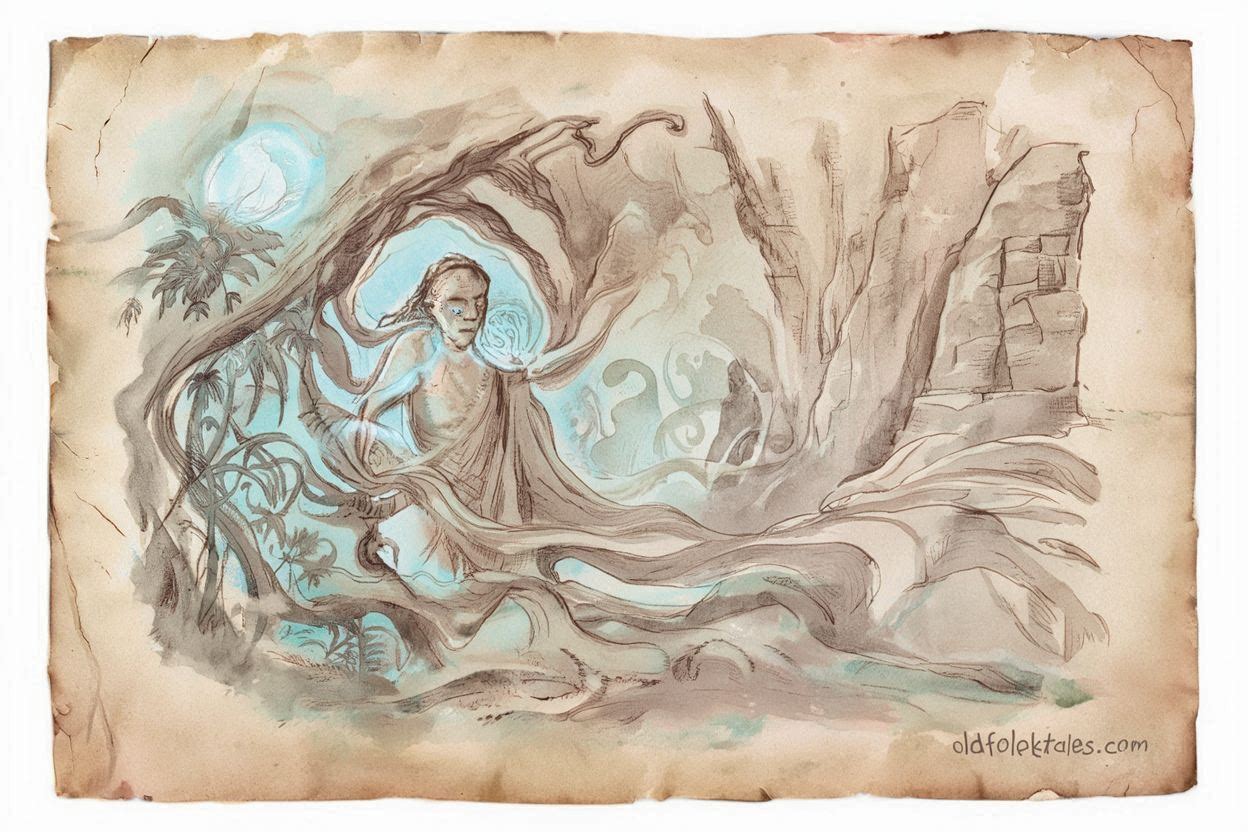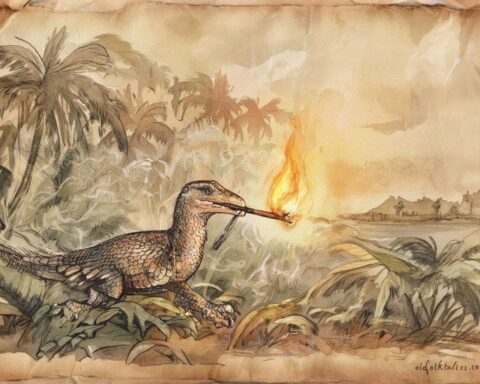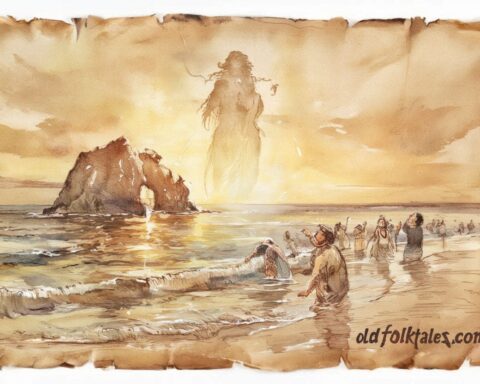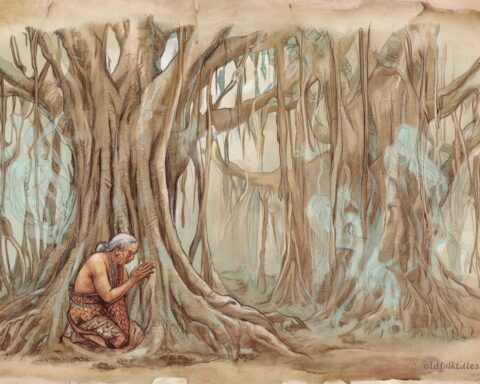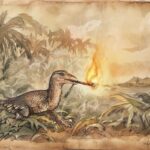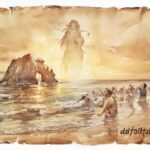Long before the people of Guam learned to fish and plant taro, there existed a world unseen by mortal eyes. Beneath the earth, deep beyond the roots of the tallest trees, lay a realm of quiet shadows and shimmering spirits. It was neither dark nor light, but filled with a stillness that echoed eternity. This was the Underworld, the home of Chaife, god of death and guardian of souls.
Chaife was not a cruel god, nor was he kind. He was balance itself. His task was to guide the spirits of the departed from the land of the living to the place where they would rest forever. In Chamorro belief, life and death were not enemies but partners. Life flowed into death, and death returned to life, just as the tide ebbs and flows upon the shores of Guam.
In the old stories, Chaife was described as tall and dark-skinned, with eyes like molten fire and hair as long as ocean weeds. His voice could calm a raging storm, and when he spoke, even the spirits stopped to listen. The people feared him, but they also respected him, for without Chaife there would be no order in the spirit world.
When a person passed away, their soul would wander for three days. During this time, the family would sing and pray, lighting fires to guide the spirit toward its path. If the soul became lost, it might linger among the living, restless and confused. To prevent this, elders would whisper the name of Chaife and call upon him to open the gate of the underworld.
On the third night, when the last flame flickered low, Chaife’s shadow would rise from beneath the earth. He would stretch out his long hands, and from his palms shone a dim blue light, like the glow of fireflies. The spirit would follow the light until it reached the boundary between worlds, the edge of life and the beginning of peace.
Some say the gateway was hidden within a cave near the cliffs of Umatac. Others say it was beneath the roots of an ancient banyan tree. Wherever it lay, the people knew that the spirit of the dead would one day pass through that sacred place, led by the watchful god who ruled below.
Chaife was not alone in his realm. The Taotaomo’na, the ancient ancestors who had become guardians of the land, often visited him. They brought news of the living world, telling him when humans honored or disrespected their ancestors. When people forgot the old rituals, Chaife would stir. The earth would tremble softly as if to remind them that death was never far away.
The people learned to live with this understanding. They treated the land as sacred because they believed their ancestors rested within it. When they entered the forest, they whispered greetings to the unseen spirits. When they fished in the ocean, they offered a small portion of their catch to the waves. In doing so, they honored Chaife and maintained the balance between the realms.
One legend tells of a young man who dared to enter the underworld seeking his lost father. The boy wandered into the forbidden cave and called out into the darkness. “Chaife, god of the deep, let me see my father once more.”
From the shadows came a slow, heavy voice. “The living do not belong in my realm. Why do you disturb my peace?”
The boy knelt, trembling but determined. “I only wish to say goodbye.”
Moved by his devotion, Chaife allowed the boy to see his father’s spirit. But before he left, the god warned him, “Every mortal who enters my realm must leave behind something precious.” The boy nodded and offered his voice, choosing silence for the rest of his days. When he returned to the living world, he could no longer speak, but he carried peace in his heart.
That story spread throughout the islands as a reminder that love can bridge even the world of the dead, but it always demands a price.
To this day, the people of Guam remember Chaife not as a being of fear, but as one of sacred responsibility. He is the unseen hand that keeps the circle of life in motion. His realm is not a place of punishment but of rest and remembrance. When someone dies, their spirit is said to journey toward the heart of the earth, guided by the whisper of Chaife’s voice.
The underworld remains hidden, but its presence is felt in the cool wind that rises after sunset, in the rustle of the leaves when no one walks nearby, and in the calm that settles over the land when night falls.
In Chamorro belief, the story of Chaife reminds the people that death is not the end. It is the beginning of another journey, a return to the ancestors and to the roots of the island itself. The same earth that gives life also welcomes the dead home.
Moral Lesson
The legend of Chaife teaches that death should be respected and understood, not feared. Life and death are part of the same eternal rhythm, and honoring one’s ancestors keeps the balance of both worlds in harmony.
Knowledge Check
1. Who is Chaife in Chamorro tradition?
Chaife is the god of the underworld who guides the spirits of the dead to their resting place.
2. How did families help the spirit of the dead find its way?
They lit fires, sang prayers, and called upon Chaife to open the gate to the underworld.
3. What lesson does the story of the boy who sought his father teach?
That love for family can reach beyond death, but every gift from the spirit world requires a sacrifice.
4. Why do Chamorro people show respect to nature and the land?
Because they believe their ancestors dwell within it, and Chaife watches over both the living and the dead.
5. What is the central message of Chaife’s story?
That life and death exist in balance, and every soul is part of the island’s eternal cycle.
6. Where does this story originate?
It comes from the Chamorro people of Guam in the Mariana Islands.
Source: CHamoru Legends: A Gathering of Stories by Teresita Lourdes Perez (2019), University of Guam Press.
Cultural Origin: Chamorro (Guam, Mariana Islands)
